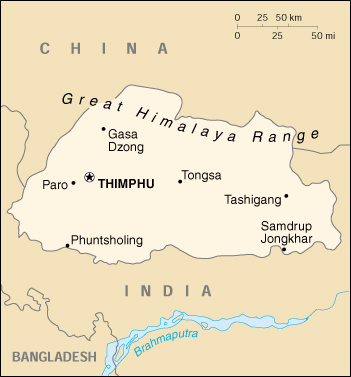Bhutan
Bhutan
We are always ready welcome volunteers for the exciting WorldGenWeb project. One of the openings is as a Country Coordinator for this country. If you have an interest in helping us develope this valuable resource by volunteering to serve as the Country Coordinator, please contact the Regional Coordinator.

Welcome to the BhutanGenWeb Project homepage. This site is part of the WorldGenWeb Project and is the local resource page for research in Bhutan.
If you need assistance with this website, please contact me. Please do not send me your queries.
The BhutanGenWebProject is in need of volunteers to host query boards, provide look-up resources, transcribe data, help with archival research and more. If you might be interested in volunteering please contact me.
General information about Bhutan
Until the early seventeenth century, Bhutan existed as a patchwork of minor warring fiefdoms when the area was unified by the Tibetan lama and military leader Shabdrung Ngawang Namgyal. To defend the country against intermittent Tibetan forays, Namgyal built a network of impregnable dzong (fortresses), and promulgated a code of law that helped to bring local lords under centralized control. Many such dzong still exist. After Namgyal's death in 1651, Bhutan fell into anarchy. Taking advantage of the chaos, the Tibetans attacked Bhutan in 1710, and again in 1730 with the help of the Mongols. Both assaults were successfully thwarted, and an armistice was signed in 1759. One of the most famous Dzongs (or Durbars) was constructed at Saureni in Samchi district. As this Dzong was constructed by a reknowned person of Nepali origin, no effort was ever made to preserve this monument and has been completely wiped out today.
In the eighteenth century, the Bhutanese invaded and occupied the kingdom of Cooch Behar to the south. In 1772, Cooch Behar appealed to the British East India Company who assisted them in ousting the Bhutanese, and later in attacking Bhutan itself in 1774. A peace treaty was signed in which Bhutan agreed to retreat to its pre-1730 borders. However, the peace was tenuous, and border skirmishes with the British were to continue for the next one hundred years. The skirmishes eventually led to the Duar War (1864–1865), a confrontation over who would control the Bengal Duars. After Bhutan lost the war, the Treaty of Sinchula was signed between British India and Bhutan. As part of the war reparations, the Duars were ceded to the United Kingdom in exchange for a rent of Rs. 50,000. The treaty ended all hostilities between British India and Bhutan.
During the 1870s, power struggles between the rival valleys of Paro and Trongsa led to civil war in Bhutan, eventually leading to the ascendancy of Ugyen Wangchuck, the ponlop (governor) of Tongsa. From his power base in central Bhutan, Ugyen Wangchuck defeated his political enemies and united the country following several civil wars and rebellions in the period 1882–1885.
In 1907, an epochal year for the country, Ugyen Wangchuck was unanimously chosen as the hereditary king of the country by an assembly of leading Buddhist monks, government officials, and heads of important families. The British government promptly recognized the new monarchy, and in 1910 Bhutan signed a treaty which "let" Great Britain "guide" Bhutan's foreign affairs. In reality this did not mean much given Bhutan's historical reticence. It also did not seem to apply to Bhutan's traditional relations with Tibet. The greatest impact of this treaty seems to be the perception that it meant Bhutan was not totally sovereign.
Source: Wikipedia
Resources
Links
There are no articles in this category. If subcategories display on this page, they may have articles.




